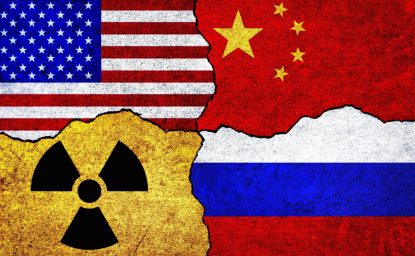Beware the Unintended Consequences of Investment Restrictions
Hon. Mark R. Kennedy
Director, Wahba Institute for Strategic Competition
Reaction to President Joe Biden’s executive order establishing an outbound investment screening mechanism reminds one of Goldilocks and the three bears. Some found it too little (and too slow), some found it too much, and some found it just right. Defense hawks decry the delay in defining and implementing robust restrictions in the face of a growing security threat. Some US venture capitalists will be most impacted. The broader business community’s views, as articulated by the US Chamber of Commerce, hopes that the ultimate rules are “targeted and administrable” and balance the need to “safeguard our national security and values” while preserving “the area of commercial opportunity where we can and should engage productively."
On one hand, the relatively calm response is surprising, given the fact that such restrictions are a radical departure from the historic US embrace of an open flow of investments (though inbound investment has been restricted for some time). On the other hand, the restrictions seem commonplace amid a bipartisan focus on limiting the rapid rise in the capabilities of the People’s Republic of China’s (PRC) military. As with all regulations, there are unintended consequences that bear watching.
First, the screening requirements seek to restrict venture capitalists in the US and new ventures in the PRC, among the most innovative actors in each nation. One should anticipate that they may seek creative avenues to continue their engagement. While the executive order seeks to prevent knowingly directing transactions that would otherwise be prohibited, the reality is complex. The real accelerant of innovation that could contribute to Chinese military capabilities is not supplying capital. The PRC can easily replace that. The key accelerant is the knowledge and knowhow that accompanies such investment by venture capitalists. To date, capital and knowhow have been bundled. Chinese startups will certainly press to decouple the two to gain access to knowhow. Some venture capitalists or consultants will be tempted, and perhaps responsive, to meeting that demand. Final regulations should consider this possibility.
Second, while the US is the dominant source of venture funding, it is not the only source. Unless there is broad coordination, other nations will seek to fill the breach. Investors in Germany and Singapore have already expressed an intent to do so. Yet there is hope that coordination with America’s closest allies can be realized. It comes in part from the fact that the Group of Seven communique on economic resilience and security acknowledged that outbound regulations may be appropriate, and the European Security Strategy said the European Commission intended to offer proposed restrictions on outbound investment by year’s end. Achieving alignment will be necessary for the rule to accomplish its objective.
Third, the logic behind the benefits of foreclosing interactions between US venture capitalists and Chinese startups rests on the idea that only the Chinese benefit from these interactions. Those more familiar with innovative ecosystems recognize that both sides benefit from such interactions as they learn from each other’s experiences. This logic also ignores the scope and scale of Chinese scientific progress.
The 2023 index of Nature magazine, a US publication, shows the PRC surpassed the US’s output of high-quality academic articles in physical sciences and earth and environmental sciences. Since 2010, Chinese universities have been outpacing US universities in awarding STEM doctoral degrees - Chinese universities awarded 49,498 in 2019 compared to 33,759 from US institutions. The PRC is also approaching the US in total research spending.
The more the US separates the technology market into two spheres, the greater the need to fund research. The shortfall in appropriating the research authorized in the CHIPS and Science Act is a concern. Actions that divide technology markets add to the need to expand trade to ensure US firms retain the market share necessary to fund the research to preserve their innovative edge. While the PRC alternative may be initially inferior, its industrial heft, sizeable internal market and strong connections with the Global South will allow it to capture sizeable market share.
As Washington Closes the Door on China, It Opens a Window of Opportunity to Canada
Xavier Delgado
Analyst, Canada Institute
President Joe Biden issued an executive order last week directing the Secretary of the Treasury to develop an outbound investment review program that will target US investments into sensitive technologies in so-called countries of concern. The White House insists that the move is a national security, not economic, action; in reality, economic policy has become increasingly intertwined with national security as Washington contends with China.
This trend of competition will lead to further restrictions on access to Chinese markets, necessitating a change in strategy for US firms and funds with investments in China’s innovation ecosystem. As firms respond to the investment restrictions set out in the White House’s executive order, Canada can position itself as an attractive alternate market. Ottawa has already released national strategies to support two of the three technologies covered by President Biden’s executive order – quantum and artificial intelligence – and participated in the inaugural North America Semiconductor Conference last year. These strategies and initiatives are supported by major funding pledges, $360 million for quantum this year, $240 million for semiconductors in 2022, and $125 million for artificial intelligence in 2017.
However, strong market conditions alone are not enough to entice displaced investments to Canada. To fully capitalize on this opening, stakeholders in Canada will need to respond quickly before competitors, particularly in the United States, go after the opportunities that China will be denied by Biden’s ban. Fortunately, Canada’s successful bids to land major electric vehicle battery investments from Stellantis and Volkswagen prove that its businesses and government are capable of doing so. If the government can mobilize industry, civil society, and itself using the electric vehicle battery blueprint, it can make itself a formidable player against global competitors.
Washington should also recognize that increased US investment into Canada, at the expense of China, will have spillover benefits for its own economy. The geographic proximity between the two countries creates synergies for US firms with operations on both sides of the border, and existing institutions such as USMCA and the NATO Defence Innovation Accelerator for the North Atlantic (DIANA) encourage collaborative research that drives innovation in both countries.
Additionally, promoting domestic investment into friendly countries empowers those governments to join the United States in pivoting from Chinese markets. Ottawa’s decision to force three Chinese firms to divest from Canadian critical minerals projects last year demonstrates its awareness of the potential security threat posed by Chinese investment. Despite this, Canadian companies that lack alternate sources of funding have no choice but to accept investments from Chinese firms. Encouraging US investors to support Canadian tech industries will enable companies to turn away from potentially dubious Chinese investors, further cutting Beijing out of the picture and helping a critical US ally strengthen its own economic security.
The Biden administration’s executive order creates an opportunity to redirect investments in sensitive technologies from a geopolitical adversary to trusted allies. Canada, in the latter category, must start engaging with funders to promote the steps it has already taken to strengthen its technology industries. The United States, meanwhile, should push to replace Chinese investment in the Canadian market by signaling to investors that Canada is a reliable and worthy alternative. If both allies can shake the apathy that sometimes plagues Canada-US economic relations and move quickly, together they can secure a strategic position that is advantageous when dealing with Beijing.
Restrictions on Outbound Investment Seeks to Balance Security
Concerns and Relationship with China
Jerry Haar
Latin America Program and Wahba Institute for Strategic Competition Global Fellow
The Biden Administration’s August 9 executive order aimed at slowing down China’s military development will leave most parties either relatively satisfied or relatively unsatisfied. Specifically, the order bans new private-equity, venture capital, and joint venture investments in quantum computing sensors and networks, along with advanced semiconductors and artificial intelligence.
Given the increasingly fractious relationship between the US and China, it’s curious that the Biden Administration would issue the executive order. However, new investment rules have been in the works going back to the Trump Administration. Last year, the Biden Administration applied export controls on semiconductors and in turn, China banned its major companies from buying technology from Micron Technology, the Boise-based company that is the largest memory-chip maker in the US.
While US dollars flowing into China’s core technological areas are relatively small, China is mainly interested in the knowledge and special capabilities since China is accelerating its pace as a dominant player in information technology. It is the world’s largest manufacturing hub, producing more than one-third of the world’s electronics. It also is the second largest final consumption market for electronic devices embedded with semiconductors, selling nearly $400 billion. With its Made in China 2025 Plan with a goal of 70% self-sufficiency in semiconductors by 2025, access to billions of dollars in below-market loans from Chinese financial institutions, and plans to build a fully indigenous supply chain, China is undoubtedly a commercial threat to the US.
While there are many China hawks who advocate for a decoupling in our relationship with China, that course of action is neither desirable nor feasible. According to a study by the Semiconductor Industry Association, decoupling could result in a decrease of up to 18% in US chip firms’ global market share and a loss of more than 124,000 jobs. It is critical for US competitiveness for American semiconductor firms to maintain access to the Chinese markets for the sale of commercial chips.
Going forward with the Biden Administration’s executive order, the administration is divided over how restrictive the new policy should be. Treasury and Commerce argue for a more modest approach, while the National Security Council and Defense lobby for a tougher stance.
Certainly, there will be a comment period that will provide another opportunity for the administration to engage with affected parties, specifically the semiconductor industry. Importantly, the $200 billion Chips and Science Act will provide $50 billion in federal subsidies for the semiconductor industry and leverage billions more from private companies in that ecosystem.
The pursuit of a mutually beneficial commercial relationship with China while ensuring the national security of the US will continue to be a daunting challenge for the current and future administrations. In the meantime, bipartisan support for an interagency panel to screen outbound foreign investments (but revised to zero in on technology), as proposed in 2021 by Sens. Bob Casey (D-Pa.) and John Cornyn (R-Texas) would be a prudent course of action.
Narrowness Defines Outbound Investment Restrictions
Cordell Hull
Wahba Institute for Strategic Competition Global Fellow
The Biden Administration recently released its long-awaited executive order and advanced notice of proposed rulemaking concerning outbound investment restrictions. Narrowness is the pervasive theme, which is likely a relief to the investing community. The order is narrow in geography (applies to China, Hong Kong, and Macau only), timing (effective only after a year-long rulemaking process), technology areas (three fairly limited, but high-end, technologies), and triggering requirements (more than 50% of Chinese company revenue in a targeted technology).
Now the action turns to Congress, engagement with allies, and of course the rulemaking process. There have been many fits and starts with this issue over the years, and whatever is next, there is still much to be written in this latest chapter of the economic statecraft playbook.
Restricting Outbound Investment Can Only Be Part of The Solution
Dr. Jeffrey Kucik
Canada Institute and Wahba Institute for Strategic Competition Global Fellow
President Biden justifies new limits on investments in Chinese technology firms as a national security measure designed to protect America’s competitive edge. While the national security argument appeals to both sides of the aisle, some in Republican leadership criticized the executive order for being too narrow.
However, the idea that Biden should cast a wider net overlooks more fundamental challenges facing America’s global competitiveness.
The first problem is logistical. In today’s economy, defining the boundaries of “security-related” technology is virtually impossible. Firms working on everything from automated driving tools to personal shopping applications spend billions developing technology they hope will guarantee a competitive advantage. But we need only to look at concerns over TikTok to see how a seemingly innocuous social media application implicates broader security concerns. No amount of investment restrictions can realistically guard against the potential for spillovers.
The second problem is local. Even if we knew exactly where to limit investment, capital flows to China aren’t the only issue. We also need to address a domestic problem neither party wants to talk about: America’s labor shortage. A major new semiconductor operation in Arizona was recently delayed due to a lack of skilled labor. That investment from an allied economy is just the latest example of how years of systematic divestment from public education, along with a declining ability to attract foreign talent, have left the US economy at risk of falling further behind.
None of this means Biden’s move is a step in the wrong direction. Yet neither can the executive order take us the whole journey. If we really care about global competitiveness – and its security implications – then policy needs a two-pronged approach, as we’re seeing with the Inflation Reduction Act and the CHIPS and Science Act. Ultimately, without continued investments in human capital, venture capital will have nowhere to grow.
A Key Datapoint in the US-China Competition Alignment Challenge
Dr. Prashanth Parameswaran
Asia Program and Wahba Institute for Strategic Competition Global Fellow
The Biden administration’s long-expected executive order on outbound investment contained few surprises and reflects its preference for a narrower, targeted approach to strategic competition with China. However, the sustainability and effectiveness of this approach remains to be seen. At home, the US Treasury rules in this space will take some time to come into effect. Even before the potential impact on investment flows can be discerned, there are already calls for a tougher approach, including from Capitol Hill. As this develops, it is also unlikely to be immune from the debates leading up to the US presidential election in November 2024, despite a broader bipartisan consensus on China policy in Washington.
Abroad, the jury is still out on the extent to which Washington can align its approach with allies and partners – including in the Indo-Pacific region – which lies at the heart of US-China competition. To its credit, the Biden administration has seen some general support for addressing outbound investment risks in forums such as the G7. It also helps that the administration has been also promoting an affirmative economic agenda through initiatives such as the Indo-Pacific Economic Framework and more clearly communicating its targeted approach to competition, be it offering reassurance on “total decoupling” fears or outlining a “small yard, high fence” view. Yet actors including Japan or the European Union also have approaches and tools of their own, which makes the task of collaborating across mechanisms more challenging in practice. This in turn risks limiting the potential impact of US moves on China’s behavior.
In much of the Global South, the executive order will be viewed as the latest in a series of tit-for-tat maneuvers in heightening US-China competition, which compounds the myriad challenges countries contend with – including inflation, food security, and climate change. Seen from this perspective, the primary hope of these countries will be that such moves do not undermine the recent flurry of US-China diplomatic activity that can at least contribute to managing or bounding a competition that shows few signs of easing anytime soon. US-China competition also feeds into the challenge these countries face at home of how to balance the benefits and risks of dealing with a risen China – one that, for all its shortcomings, accounts for up to half of economic growth in the Indo-Pacific region this year, which in turn comprises about 70 percent of global growth.
Authors


Research Director, Washington Forum on the Canadian Economy

Professor of International Business and Executive Director for the Americas, College of Business, Florida International University


Associate Professor in the School of Government and Public Policy and the James E. Rogers College of Law, University of Arizona

CEO and Founder, ASEAN Wonk Global, and Senior Columnist, The Diplomat

Wahba Institute for Strategic Competition
The Wahba Institute for Strategic Competition works to shape conversations and inspire meaningful action to strengthen technology, trade, infrastructure, and energy as part of American economic and global leadership that benefits the nation and the world. Read more


Canada Institute
The mission of the Wilson Center's Canada Institute is to raise the level of knowledge of Canada in the United States, particularly within the Washington, DC policy community. Research projects, initiatives, podcasts, and publications cover contemporary Canada, US-Canadian relations, North American political economy, and Canada's global role as it intersects with US national interests. Read more

Explore More
Browse Insights & Analysis
US Inaction Is Ceding the Global Nuclear Market to China and Russia

Promoting Convergence in US-Brazil Relations


